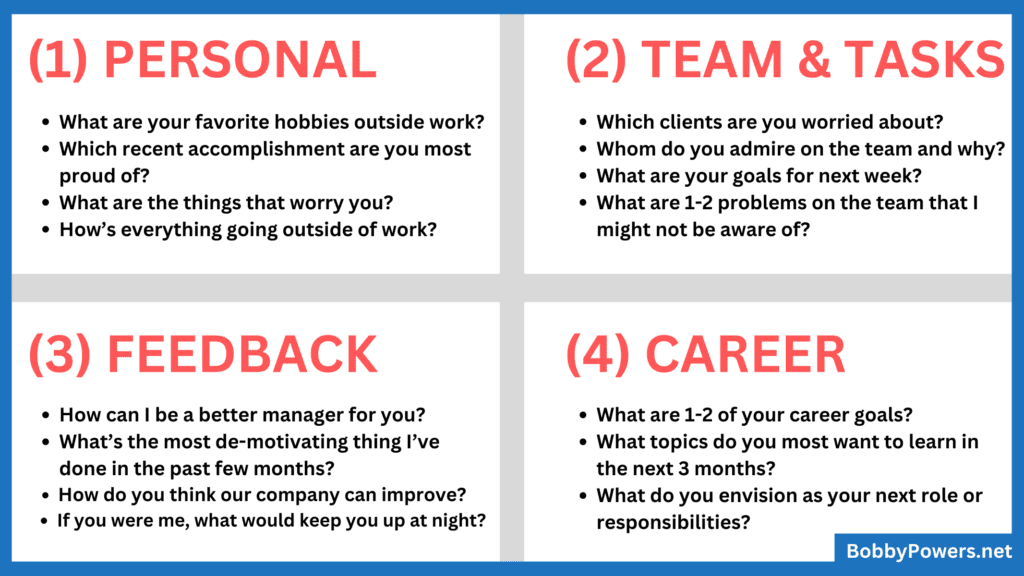I Think You’re Making This Mistake in Your 1-on-1s
I’ve trained over 100 managers in the past few years, and many of them have struggled with the same problem: ineffective 1-on-1 meetings.
Here are a few warning signs your 1-on-1s probably aren’t effective:
- You or your direct report frequently want to cancel the meeting.
- Your 1-on-1s feel boring.
- Your meetings often feel like they could have been an email.
If one or more of those descriptions sound like your 1-on-1s, your meetings could use a tune-up.
The most common reason I’ve seen for ineffective meetings is when the manager only covers tactical items, like checking in on client work, daily tasks, and urgent day-to-day items. Those are all important topics, but they shouldn’t be the only things discussed in 1-on-1s.
Unfortunately, it’s easy to default to tactical topics like those. They’re somewhat urgent, they’re top-of-mind, and they’re easy to discuss.
But if you only talk about those topics, you’ll never experience the real power of 1-on-1s: building a deeper connection with your employee and developing them in their career.
The 4 Quadrants
I’ve found that the best managers cover four topics in their 1-on-1s:
- Personal: What’s going on in their personal life (i.e., outside work)
- Team & Tasks: What’s going on with their tasks, co-workers, and clients
- Feedback: What feedback they have for you and you have for them
- Career: How they want to progress in their career

You’ll notice that the tactical topics mentioned earlier are all found in Quadrant 2 of the grid: the “Team & Tasks” quadrant. This quadrant is important but it’s only one-fourth of the total ground you should cover in your 1-on-1s. Don’t get stuck only talking about Quadrant 2!
Quadrant 1 (Personal) is important because it helps you build rapport with your direct report. The best way to develop a relationship with someone is to learn more about who they are as a person, not just who they are at work. And by learning about their interests, you’ll learn more about the types of things that motivate them.
Quadrant 3 (Feedback) is focused on helping your employee improve. By explaining their gaps/weaknesses, you’ll help them understand what they need to address to get future promotions, raises, etc. But in addition to giving feedback, it’s also important for you to ask them for feedback. Ask for their perspective on how you can improve as a leader, how the team is doing, and how they feel about their job and the work culture.
Quadrant 4 (Career) is the most strategic quadrant on the grid. It’s where you learn about their career goals and discuss how they’re progressing against those goals. If you overlook this quadrant, they may decide to leave the company because they don’t feel like they can grow. But if you frequently discuss how their work connects with their overall career ambitions, they’ll be more likely to remain engaged.
5 Tactical Tips for Improving 1-on-1s
There are several things you can do to immediately improve your meetings with direct reports:
- Meet frequently and don’t cancel. For most manager/employee relationships, weekly is the right cadence, but some team members may only need biweekly or monthly meetings (like tenured staff or those who don’t need much direction).
- Cover each quadrant at least every 2–3 months. Don’t stress out about covering every quadrant every meeting, but it’s important to touch on Quadrants 1–3 every 1–4 weeks and Quadrant 4 at least every quarter.
- Consider scheduling bimonthly or quarterly “development check-ins.” Quadrant 4 (Career) is the toughest quadrant to prioritize because it’s usually the least urgent. But remember, just because it’s not urgent doesn’t mean it’s not important. Many managers have success with scheduling a separate meeting to discuss career goals. These are generally recurring invites that take place every 2–3 months.
- Create a shared agenda. Use a tool like Google Docs to track an ongoing list of topics to discuss in your next meeting. Both parties should bookmark the document and add questions/topics anytime an idea hits your mind. This serves as a running list of agenda items so you don’t have to rely on remembering agenda items in the moment.
- Switch it up: ask different questions than you normally do. It’s easy to get into a rut of asking the same old questions every meeting. Challenge yourself to ask new questions. Below are some of my favorites.

By covering all four quadrants in your 1-on-1s, you can avoid the trap of only discussing urgent tactical issues.
You’ll also build deeper relationships with your employees, keep them around much longer, and help them develop into incredible future leaders of your organization.
Want to become a stronger leader?
Sign up to get my exclusive
10-page guide for leaders and learners.




